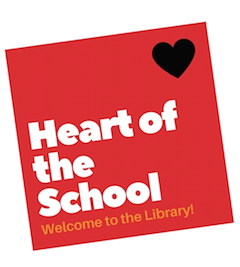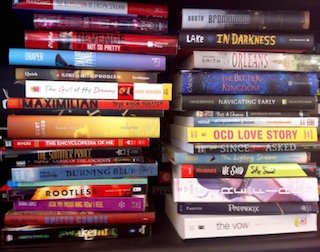Books Without Borders: A Reading Challenge Idea
A MiddleWeb Blog

At that time I felt shaken to the core and more concerned than ever about the students that I serve and love. I wondered how I could protect them, nurture them, and help them grow into adults who would celebrate diversity. Now, six months later, I find myself circling back to that theme and the commitment I made to keep social justice at the heart of my teaching.
I believe that the best way for me to engage in the war against hate is to do so peacefully. I know, a “peaceful war” sounds like an oxymoron. But, it’s not. Helping students to gain knowledge about people who are, in one way or another, different from themselves, is a good first step. One of the best ways to gain knowledge is through reading. It doesn’t get much more peaceful or powerful than that.
Below is a fun and meaningful reading challenge to help students learn about people who may otherwise have been strangers in their worlds.
Books Without Borders
As my school’s librarian I encourage my students to read books with diverse characters throughout the entire school year, but during the month of February we have a special reading challenge, that I call Books Without Borders. It was designed after I had read about a similar challenge, Reading Without Walls. This challenge was designed by American Born Chinese author Gene Luen Yang. In his version, Yang asks readers to do three things:
- Read a book about a character who does not look or live like you.
- Read a book about a topic you don’t know much about.
- Read a book in a genre or format you’re not used to reading.
I loved the idea but wanted to streamline it a bit, focusing it for my readers so that they would either read deeply about a different place or culture or widely about many different places or cultures. I decided that ultimately, I wanted students to read a minimum of ten books that featured diversity. Thus, the Books Without Borders challenge was created.
I started by going through my library and pulling out good picture books and novels to fit the challenge. I looked for books that featured people, places, ideas, and stories dissimilar from the norm in my small town. I also made sure that my collection contained up-to-date texts on a variety of countries and at a variety of reading levels. I repurposed an old bookcase and labeled it “Books Without Borders!” I quickly realized that I needed more books and sought out and received grants to get them (see below.)
Last, I developed a simple form for students to record their reading. The form includes a sheet with ten lines for students to write ten titles on. I added a cover sheet to describe the challenge, a simple (and optional) reflection form, and a map that students might use to mark the locales of their books. You can find, modify, and use the materials at Google Drive (or download a Word file here).
The Nuts and Bolts
My hope is that some who read this post will try a similar program, adapted for your students and your grade levels. Below are several tips you might find helpful to get you going.
Set a Timeline.
I decided to run the official challenge for the month of February (pick any month you like!). It is a total coincidence that February is also Black History Month. It works though. In some ways it works really well! My husband and I pledge to read only African American authors every February and so the books I am reading are good models for the students and the adults in my community. Follow me on GoodReads to see what I am reading.
Get the Word Out!
In my experience, programs like this work best when there is a lot of buzz about them. I made and posted a video to our school’s Facebook page that describes the challenge to the community, sent home a flier talked about it in the library, and made another short video for teachers to show in their classroom as a reminder to students.
Connect with the Public Library
I often connect with the public library. The youth librarian there is interested in collaborating to help build a community of readers that extend beyond the walls of the school and I am all about that! The public library advertises the program, keeps the fliers, and has made a wonderful “Books Without Borders” display. The connection keeps the challenge alive and accessible.
Read Them Aloud!
As the ever-brilliant Valentina Gonzalez reminds us in this post, “Reading aloud is actually an excellent strategy for all the students in our middle grades.” Don’t hesitate to read a text or two out loud to your students of any age. Let them record the books you read on their challenge as a head start of sorts. Of course, some middle grade students will balk at reading picture books because they think of them as “baby books.” Make sure to talk to children about why that is not the case! The illustrations and text in picture books are often more complex than those found in popular novels.
Make It an Annual Challenge
This is the third year I have offered the “Books Without Borders” challenge. My young readers know how it works and are excited to dive into new cultures and ideas in our ever-growing library of diverse texts.
Celebrate!
In another Heart of the School post, I wrote about the importance of joy in the classroom. Adding a celebration to the challenge is a great way to cultivate joy! I offered students who completed the challenge $20 Book Bucks to spend in the free bookstore in the back of the library. More exciting, as students finished, their names were added to a drawing. Ten lucky winners came to my house to eat a home-cooked meal (made mostly by the wonderful youth librarian at the public library) of foods from around the world! The students loved visiting my house and trying the food. Last year’s winners spread the word and this year, I have more participation than ever!
Where to Get the Books
Having lots and lots of books is the key to making this project work. The internet is loaded with great lists to help you get started. Three resources that I really like are the Multicultural Children’s Book Day, School Library Journal’s Resources, and WNDB (We Need Diverse Books) lists.

I was able to augment my collection in two ways. Donors Choose often has amazing matching grants. Last year, I got a matching grant for $500 worth of picture books and novels with diverse characters and settings. The process was simple and enjoyable. You might also check out Teaching Tolerance and talk with your parent organization or education foundation about funding.
Once you procure funds, check out First Book. The First Book Marketplace has thousands of books tagged as having a “diversity and inclusion” focus. The books cost, on average, less than $4 each! The books are high quality trade books offered at a fraction of the usual cost after you register and make a free account.
Next Steps
As I’ve mentioned before, I had the wonderful Carl Grant as a professor in my undergraduate education program. I remember him saying, “If you want to rid the world of racism, start by getting an ice cream cone with a person of a different skin color than yours.“ This year got away from me fast. Next year I want to include more activities that integrate real world interactions between people into the challenge. Below are three simple ideas I am playing around with.
-
-
- Bring in speakers. I would love to bring in speakers and/or guest readers from the places and cultures that students are reading about. This could happen in the school or the public library.
- Skype with the world! Next year, I am going to spend more time investigating how a Mystery Skype or two could fit in. In a Mystery Skype, students talk to other classrooms or other guests and try to determine where they are located through a question and answer session. It sounds like fun and I love that it could help inspire the desire to travel in students.
- Flipgrid. If you still haven’t caught #flipgridfever, it is time to jump on the bandwagon! Flipgrid is an amazingly easy-to-use video making platform. Teachers make a grid in minutes and people from all over the world can interact through video! Next year, I am going to make a “global grid” and ask people from everywhere and anywhere to share something about their cultures. Look at this Flipgrid where students talk about peace as an example.
-
Windows and Mirrors
Have you ever heard the idea that books can serve as both windows and mirrors? It is brilliant, really. The idea is that when we read we see through windows into other worlds and/or we look in mirrors to examine ourselves.
I often define reading as understanding for my students. What I mean is this – if what is “read” is not comprehended, it wasn’t read at all. The idea of windows and mirrors deepens this definition; not only do texts need to be comprehended at a surface level, but also at a deeper level that helps us understand the world and how we all fit in it.
I hope you help your students open some windows and look in some mirrors. I hope you try some variation of Books Without Borders at your school. If you do, let me know how it goes!
Stacked books image: School Library Journal



































Wonderful article, full of inspiration and good ideas to get kids reading diverse books. Look to writers’ clubs in your area. They are often seeking classrooms in which to read their books or give author talks. Best wishes!
Glad you liked it, Mary! Thanks for the comments and suggestion.
Excellent article with great ideas for helping readers to expand their understanding of the world. I plan to share the article in my college reading courses.
I am so happy to hear that you found the post useful!